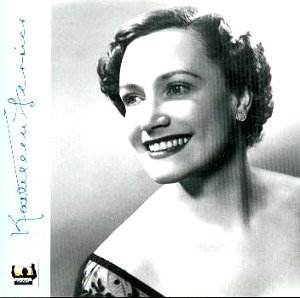As Tahra’s notes make clear Ferrier didn’t tour much
in Italy. Her debut there was in July 1950 with Karajan and the Vienna
Symphony in the Mass in B minor and she returned the following year.
Her repertoire then centred on arias from Rinaldo and Xerxes and Kindertotenlieder
(conductors, Antonio Pedrotti and Klemperer). The recital preserved
by Tahra was recorded on 6th February by RAI Milan with accompanist
Giorgio Favaretto. What will be most exciting to Ferrier admirers is
that five of the items do not otherwise appear in her known discography
nor, at the moment, are they known to exist elsewhere. For the record
then – Semele, the Monteverdi, Lotti, the Brahms Sonntag and the traditional
The Spanish Lady are all discographic firsts, and lasts, even in this
imperfect form of a live radio recital.
Where e’er you walk is the only recorded example
of her singing this quintessential tenor aria. There is a definably
oratorio austerity to her phrasing that announces real gravity – but
it can’t persuasively, I think, be argued that she was as idiomatically
instinctive an exponent as her male contemporaries. Her colleague Heddle
Nash, with whom she sang on numerous occasions, recorded it with such
heartbreakingly floated head voice that Ferrier sounds relatively mean
spirited in comparison. There is however a rather delicious air of felicitous
wit in Like as the love-lorn turtle – her crisply humorous consonants,
her verbal finesse, her gracious ease at slow tempo, the splendid divisions,
all announce a performance of stature – and her only other known recording
was a live taping in Oslo in 1949. No one would expect her contralto
to be as nimble as say, Elsie Suddaby, in Hark! The echoing air but
she is still more than gainly (and once more an Oslo ’49 live recital
performance exists). Her Monteverdi (new to her discography) is deeply
intense and expressive with a formal, interior drama that she was supremely
gifted at displaying. Once again the Lotti is new – her dynamics are
splendid, runs floated, no hint of unwieldiness or heaviness despite
the association of this song with such as, say, Melba (who had recorded
it in London forty years before). Her rubati here are master classes
in how subtly to inflect repeated phrases. The Gluck of course was her
signature tune, if we can permit the vulgar phrase. Her diminuendi,
ritardandi and the occasional fruity portamento are all part of her
expressive armoury – but she does get progressively slower in echt romantic
style and there is a little pre-echo in places.
Damage afflicts the Schubert (she was to be recorded
with Britten in it the following year) – thumps and gouges but the Brahms
is full of affectionate simplicity and listen – in detail – to her minute
vowel lengthening, her sense of metricality and the open and youthful
freedom she brings. And it’s another discographic addition. Strangely
her diction is rather poor in the Stanford – but her diminuendi are
special as is the great cumulative feeling of delicacy and depth that
she engenders (a BBC transcription with Stone exists of it as well).
Ca’ the Yowes is wonderful, affecting and beautiful in equal
measure – even if her tendency excessively to roll her "r"
– endemic to certain British singers of that generation – might seem
too pervasive. The conversational ease of The Spanish Lady is
affectionate and sly – and new as well. I won’t forget her parlando
phrase "catching a moth" or the quickly sly amazement of her
singing of the word "feet". Small details but they succeed
in expanding the canvas of the song immeasurably. The recital is rounded
out by the June 1950 excerpts from the St Matthew Passion given by the
Vienna Symphony and Karajan. These are much better known than the Milan
recital and include Ferrier’s deeply moving Erbarme dich, mein Gott
with Walter Schneiderhan’s expressive violin accompaniment.
That’s the good news, now for the bad. The acoustic
in the Milan recital is so resonant that some form of artificial reverberation
must have been added at some stage. The recital has in fact appeared
before – on a Rococo LP – and knowing Tahra’s generally non-interventionist
approach to their remastering I would be hesitant to apportion blame
there (any more than I would with Rococo). The echo, however - and whenever
- it was introduced, remains very problematic. In the end of course
the recital’s value far outweighs sound problems. Because of the previously
unissued items this will be a mandatory purchase for Ferrier admirers.
Jonathan Woolf

